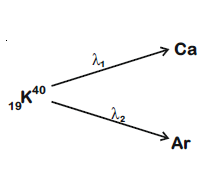Q. In a radioactive sample, $^{40}_{19} K$ nuclei either decay into stable $^{40}_{20} Ca$ nuclei with decay constant $4.5 \times 10^{-10}$ per year or into stable $^{40}_{18}\, Ar$ nuclei with decay constant $0.5 \times 10^{-10}$ per year. Given that in this sample all the stable $^{40}_{20}Ca$ and $^{40}_{18}$ $Ar$ nuclei are produced by the $^{40}_{19}K$ nuclei only. In time $t \times 10^{9}$ years, if the ratio of the sum of stable $^{40}_{20}\,Ca$ and $^{40}_{18}\, Ar$ nuclei to the radioactive $^{40}_{19}\, K$ nuclei is $99$, the value of t will be : [Given $ln\, 10\, =\, 2.3$]
Solution:
$\therefore \frac{dN}{dt}=-\lambda_{1}N-\lambda_{2}N$
$\therefore \frac{dN}{dT}=-\left(\lambda_{1}+\lambda_{2}\right)dt$
$\Rightarrow N=N_{0}e^{-\left(\lambda_{1}+\lambda_{2}\right)t}$
For $N = N_0 - 99%$ of $N_0 = 0.01 N_0$
We get
$t=\frac{In\,100}{\lambda_{1}+\lambda_{2}}=\frac{2.3\times2}{5\times10^{-10}}$
$t=9.2\times10^{9}$ year
